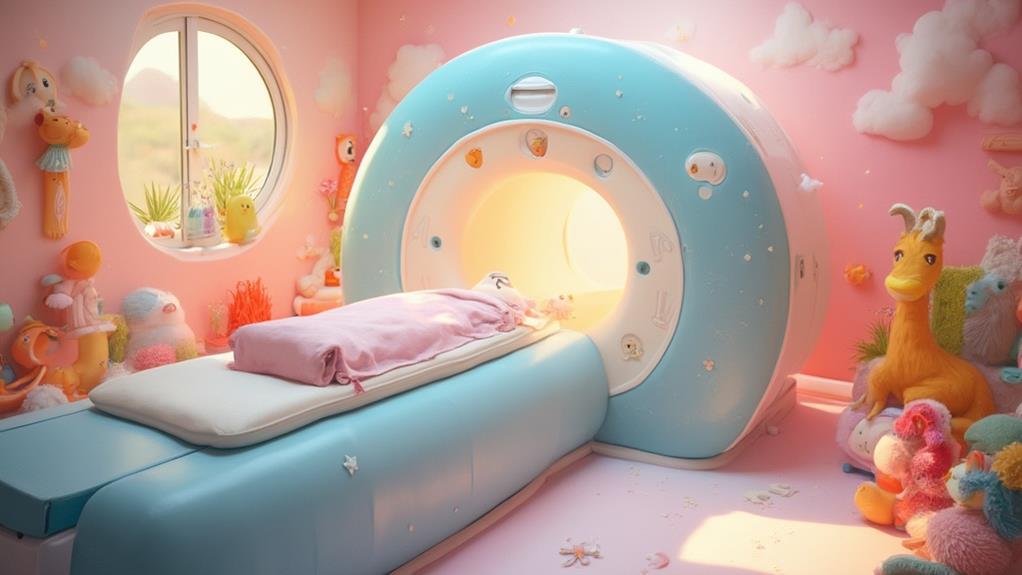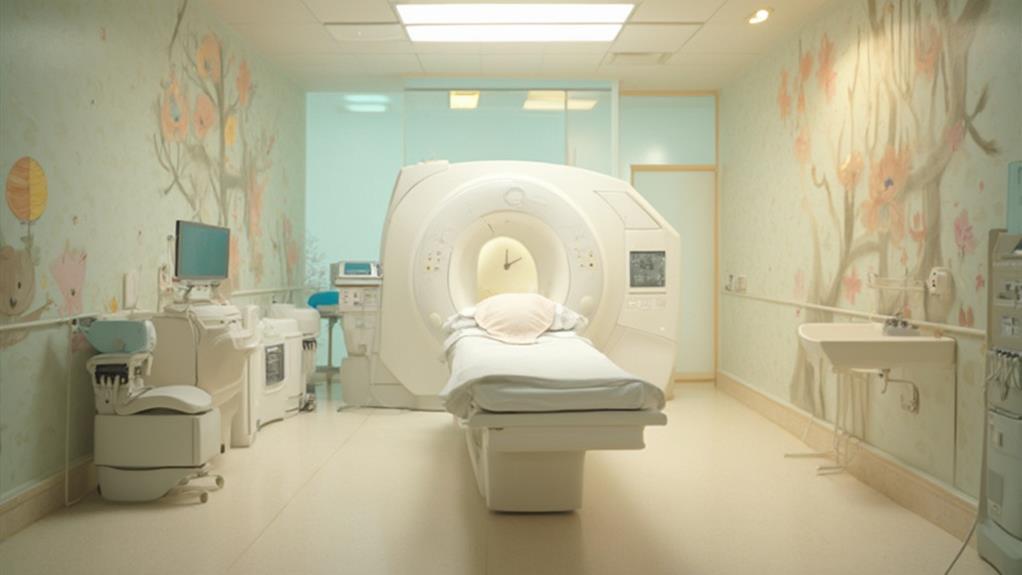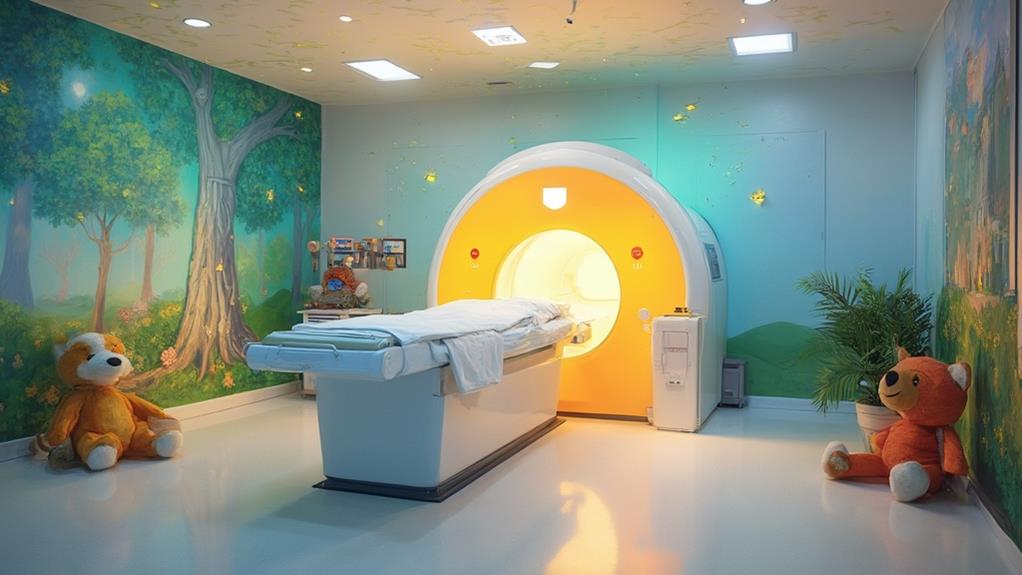Pediatric MRI scans are an essential non-invasive diagnostic tool that provides detailed images of a child's internal structures, aiding in the diagnosis of various medical conditions without the risks associated with ionizing radiation. These scans are especially useful in evaluating symptoms like headaches, vertigo, and visual disturbances. Safety protocols, such as screening for contraindications and offering a child-friendly environment, are indispensable. Preparing the child with age-appropriate explanations and relaxation techniques enhances the scanning process. The benefits include early detection of conditions and eliminating the need for invasive procedures. Subsequent sections will explore key aspects like sedation requirements and tailored safety measures.
MRI Highlights
- Pediatric MRI scans use no ionizing radiation, making them safer for children.
- They offer detailed imaging to diagnose conditions like neurological disorders, tumors, and cardiovascular issues.
- Rigorous safety protocols ensure patient safety, particularly regarding metallic implants.
- Child-friendly preparation and environments help reduce stress and anxiety during the procedure.
- Sedation needs vary by age, development, and procedure duration for safe and effective imaging.
Definition of Pediatric MRI

A Pediatric MRI (Magnetic Resonance Imaging) scan is a non-invasive diagnostic tool designed primarily to visualize the internal structures of a child's body. Its purpose is to assist in accurately diagnosing various medical conditions without the use of ionizing radiation, which is critical for pediatric patients.
The MRI scan can be particularly helpful in evaluating symptoms like vertigo, headaches, or vision issues in children. Ensuring safety during the procedure, MRI safety protocols are rigorously followed, and special child preparation tips are employed to make the experience as comfortable and stress-free as possible for young patients.
Pediatric MRI Purpose
Pediatric MRI's primary purpose is to provide a detailed, non-invasive means of imaging the internal structures of a child's body, aiding in the accurate diagnosis and monitoring of various medical conditions. Utilizing magnetic resonance imaging (MRI) technology, clinicians can obtain highly precise images of organs, tissues, and skeletal structures without the need for radiation, which is a key consideration in pediatric care.
MRI scans are particularly advantageous in pediatric settings for several reasons:
- Detailed Imaging: MRI offers superior tissue contrast compared to other imaging modalities, which is essential for detecting abnormalities in the developing bodies of children. This high level of detail enables the identification of subtle and complex medical issues.
- Non-Invasiveness: Unlike surgical procedures, MRI scans are non-invasive, thus minimizing physical trauma and associated recovery times. This feature is especially important for young patients whose bodies are still developing.
- Comprehensive Evaluation: MRI is versatile and can be used to assess a wide range of conditions, from neurological disorders and musculoskeletal issues to cardiovascular anomalies, thereby providing a holistic view of a child's health.
MRI Safety Protocols
Guaranteeing the safety of pediatric patients undergoing MRI scans necessitates the implementation of stringent MRI safety protocols. The unique physiological and psychological characteristics of children require specific adaptations to standard practices.
Key elements of these protocols include thorough screening for contraindications, such as the presence of metallic implants or medical devices that could pose risks in the magnetic field.
Before the scan, healthcare providers meticulously review the patient's medical history and conduct safety checks to identify any potential hazards. Additionally, MRI machines used for pediatric patients often have lower noise levels and faster scan times to minimize discomfort and the need for sedation.
Environmental safety measures also play a critical role. Specialized pediatric MRI suites are designed to be child-friendly, reducing stress and promoting a calm atmosphere. Critical safety equipment, like crash carts and emergency medications, must be readily accessible to handle any adverse reactions.
Furthermore, continuous monitoring during the procedure secures swift intervention if anomalies arise. Technicians and radiologists need to be well-versed in pediatric care, reinforcing the necessity for specialized training in recognizing and addressing the specific needs of young patients, thereby enhancing overall safety during the MRI process.
Child Preparation Tips
Building upon the foundational importance of MRI safety protocols, adequately preparing children for their MRI scans is equally indispensable. Proper preparation not only alleviates anxiety but also contributes to a smoother scanning process. Parents and caregivers play a pivotal role in ensuring that children are calm, comfortable, and cooperative during the procedure.
To achieve this, consider the following preparation tips:
- Explain the Procedure: Use age-appropriate language to explain what an MRI scan entails. Discuss how the machine will make loud noises but that these sounds are normal and part of the process.
- Practice Relaxation Techniques: Encourage your child to engage in deep breathing exercises or brief guided meditations. These techniques can help reduce anxiety and make it easier for the child to remain still during the scan.
- Familiarization with the Environment: If possible, arrange a visit to the MRI center beforehand. This can help demystify the equipment and surroundings, making the actual day less intimidating.
Thus, by addressing the child's psychological and emotional needs through these measures, caregivers can foster a more positive experience, ensuring that the procedure is as stress-free and efficient as possible.
Benefits

Pediatric MRI scans offer several notable benefits, making them an indispensable tool in modern medicine. As a non-invasive diagnostic method, they allow for early detection of various conditions without the need for surgical intervention, thereby minimizing associated anesthesia risks.
Unlike CT scans, MRIs are particularly adept at spinal cord imaging, which can be vital in diagnosing conditions in children. Additionally, the enhanced image quality provided by MRI technology guarantees more accurate diagnoses, further facilitating effective treatment planning.
Non-invasive Diagnostic Tool
How transformative is the benefit of a non-invasive diagnostic tool in pediatric care? Magnetic Resonance Imaging (MRI) stands out as a quintessential example in this domain. The non-invasive nature of MRI scans confers several key advantages, particularly indispensable when dealing with pediatric patients.
Enhanced Safety: Unlike traditional imaging techniques that involve ionizing radiation, MRIs utilize magnetic fields and radio waves, ensuring there are no radiation risks. This is especially pertinent for children, as they are more vulnerable to the adverse effects of radiation.
Reduced Need for Invasive Procedures: MRI obviates the necessity for surgical interventions solely for diagnostic purposes. This is pivotal, given the inherent risks associated with invasive procedures, including infection and anesthesia complications.
Exhaustive Imaging Capability: MRIs have the ability to generate detailed images of soft tissues, bones, and organs. This expansive imaging aids in accurately diagnosing a wide plethora of conditions without subjecting young patients to multiple tests.
Early Detection Capabilities
Why is early detection pivotal in pediatric healthcare? Early detection is essential for identifying health conditions at a stage when they are most treatable and manageable, remarkably improving outcomes for young patients. In pediatric care, MRI scans play a critical role in this early detection process, owing to their unparalleled ability to visualize internal structures without radiation exposure. This advantage enables the timely identification of various conditions such as neurological disorders, tumors, and congenital anomalies.
MRI technology facilitates precise and detailed imaging, allowing healthcare providers to diagnose conditions earlier than other diagnostic tools might. This timeliness is particularly indispensable in pediatrics, where a child's developing body and brain are more susceptible to the long-term effects of delayed treatment. Early intervention can prevent complications, ensure better management of chronic conditions, and improve overall prognosis, enhancing the child's quality of life.
Moreover, MRI scans help in monitoring the progression of a disease, providing detailed follow-up information that can guide ongoing treatment plans. By enabling early and accurate diagnosis, MRI scans not only enhance individual patient care but also contribute to more efficient healthcare systems, underscoring the collective commitment to better pediatric health outcomes.
Improved Image Quality
Beyond the advantages of early detection, the significant benefit of MRI scans in pediatric healthcare lies in their exceptional image quality. This superior image clarity plays a vital role in diagnosing and treating young patients, allowing healthcare professionals to make well-informed decisions based on detailed visual information.
The capabilities of MRI technology provide three key benefits:
- Enhanced Resolution: MRI scans offer high-resolution images that reveal intricate details of internal structures. This level of clarity is essential for identifying subtle abnormalities that other imaging techniques might miss, particularly in the developing bodies of children.
- Multiparametric Imaging: MRI scans can capture various tissue contrasts and functionalities without the use of ionizing radiation. This multifaceted approach allows for extensive assessments of diverse conditions, ranging from neurological disorders to soft tissue injuries, ensuring a more thorough diagnosis.
- Non-Invasive Nature: The non-invasive nature of MRI scans means they can be performed without the physical intrusion required by some other diagnostic methods. This aspect is especially beneficial in pediatrics, where minimizing discomfort and stress is paramount.
Reduces Anesthesia Risks
MRI scans' ability to reduce anesthesia risks is a pivotal benefit in pediatric healthcare. Traditionally, children often require sedation or general anesthesia to remain still during imaging procedures. Anesthesia carries inherent risks, including respiratory complications and adverse reactions, which are particularly concerning in young patients. By employing advanced MRI technology, healthcare providers can drastically minimize these risks.
Several technological and procedural innovations contribute to this reduction. Faster scanning techniques and improved image quality allow for shorter examination times, decreasing the likelihood that a child will need to be sedated. Moreover, the development of child-friendly MRI environments, replete with interactive distractions and engaging visuals, enhances children's cooperation and comfort, further diminishing the necessity for anesthesia.
Perhaps most critically, the reduction of anesthesia use directly translates to fewer post-procedural side effects, expediting recovery time and improving overall patient safety. This approach aligns with the overarching goal of pediatric care: to facilitate diagnostic accuracy while prioritizing the child's well-being. By mitigating the risks associated with anesthesia, MRI scans foster a safer, more comfortable diagnostic process, embodying a pivotal advance in pediatric diagnostic practice. This balance of efficacy and safety underscores the importance of progressive imaging technologies in modern healthcare.
Sedation Requirements

When conducting MRI scans on pediatric patients, sedation requirements can vary noticeably based on several factors, including the age of the child, the duration of the scan, and the child's ability to remain still. It is crucial to adhere to age-based sedation guidelines and implement stringent safety and monitoring procedures to safeguard the well-being of young patients during the procedure. The choice of sedative methods must be carefully tailored, taking into account the specific needs and medical condition of each child, as outlined in the following table:
| Age Group | Recommended Sedation | Monitoring Protocols |
|---|---|---|
| Infants (0-1 year) | Oral or IV sedation | Continuous vital signs monitoring |
| Toddlers (1-3 years) | Oral, IV sedation, or anesthesia | Continuous vital signs and respiratory monitoring |
| Preschool (3-5 years) | Moderate sedation or anesthesia | Continuous cardiac and respiratory monitoring |
| School-Age (5-12 years) | Moderate sedation, anesthesia if needed | Continuous vital and oxygen saturation monitoring |
| Adolescents (12+ years) | Minimal or moderate sedation | Periodic vital signs monitoring |
The above table provides a clear guideline for sedation choices and monitoring protocols based on the child's age group.
Age-Based Sedation Guidelines
Understanding the intricacies of age-based sedation guidelines is essential in the domain of pediatric MRI scans. The purpose of sedation in pediatric patients is to guarantee they remain still during the procedure, thereby obtaining high-quality images without causing distress or discomfort. Age-specific guidelines help tailor sedation protocols to each child's developmental stage and physiological response to medication.
Infants (0-1 year) often require higher sedation levels due to their inability to follow instructions to stay still. Sedation usually involves short-acting agents that guarantee quick recovery and minimal side effects.
Toddlers and Preschoolers (1-5 years) typically need moderate to deep sedation. Their developing cognitive abilities may cause anxiety, making sedation critical to prevent movement and assure procedure success.
School-Age Children and Adolescents (6-18 years) may handle MRI scans with minimal or no sedation, depending on their ability to remain still and follow instructions. Distraction techniques, such as audiovisual aids, can be beneficial.
Adherence to these guidelines guarantees the safety and comfort of pediatric patients while optimizing the effectiveness of MRI scans. Consequently, professionals must be knowledgeable and diligent in implementing appropriate sedation strategies.
Safety and Monitoring Protocols
Ensuring the safety and monitoring of pediatric patients undergoing sedation for MRI scans is paramount in pediatric radiology. Comprehensive safety protocols are meticulously crafted to address the unique physiological and psychological needs of children.
Continuous monitoring, using advanced equipment, helps in tracking vital signs such as heart rate, oxygen saturation, and blood pressure. This vigilance guarantees immediate intervention if any deviations occur.
Pre-sedation assessment is a pivotal step, involving a thorough review of the patient's medical history, allergies, and current medications. This helps in tailoring sedation plans to minimize risks. During the MRI procedure, trained pediatric care teams remain present to supervise and respond to any immediate concerns.
Effective communication with the child's guardians is also crucial. Clear instructions and expectations regarding pre-procedure preparations, such as fasting guidelines, are shared to mitigate sedation risks. Post-sedation, children are closely observed until they are fully awake and stable, ensuring there are no adverse effects from the sedative agents used.
Proper documentation of all procedures and responses is essential for future reference and enhancing safety protocols. Adhering to these rigorous monitoring protocols exemplifies dedication to safeguarding pediatric patients' well-being during MRI scans.
Choosing Sedative Methods
Choosing the appropriate sedative methods for pediatric MRI scans involves a nuanced understanding of each child's specific needs and medical background. The goal is to guarantee that the child remains calm and still during the scan to produce high-quality images, while also prioritizing the child's safety and comfort. Sedation decisions should be made collaboratively by healthcare providers and tailored to individual requirements.
To determine the most suitable sedative approach, consider the following factors:
- Age and Developmental Stage: Infants and young children may require deeper sedation compared to older children who might manage with minimal sedation or none at all.
- Medical History and Current Health: Children with preexisting conditions or allergies may need special considerations and alternatives to standard sedatives to avoid adverse reactions.
- Procedure Duration and Specificity: The length and complexity of the MRI scan can influence the selection of sedation. Longer and more detailed scans may necessitate more profound sedation.
Selecting an appropriate sedative method for pediatric patients is a critical aspect that guarantees the efficacy of MRI imaging and the overall experience for the child. By considering individual factors, healthcare providers can optimize care and achieve precise diagnostic outcomes.
MRI FAQ
How Do I Prepare My Child for Their MRI Scan?
To adequately prepare your child for their MRI scan, explain the procedure in simple terms, encourage them to remain still, and guarantee they are comfortable. Comfort objects and distractions can help alleviate anxiety during the process.
Are There Any Risks Associated With Pediatric MRI Scans?
Magnetic Resonance Imaging (MRI) is generally safe; however, there are minimal risks, such as slight discomfort or anxiety caused by the enclosed space. It is essential to inform the technician of any metal implants or conditions.
Can Parents Be Present During Their Child's MRI Scan?
Yes, parents are often allowed to be present during their child's MRI scan to provide comfort and reassurance. Their presence can help alleviate anxiety, ensuring a smoother procedure for both the child and healthcare providers.
What Should My Child Wear for the MRI?
For the procedure, your child should wear comfortable, loose-fitting clothing without metal components. If this is not feasible, the facility may provide appropriate attire to guarantee safety and precision during the examination.
How Long Does a Typical Pediatric MRI Scan Take?
A typical MRI scan generally takes between 30 to 60 minutes. However, the duration can vary based on the specific requirements and complexity of the imaging study. Ensuring patient comfort and cooperation is paramount for ideal results.
